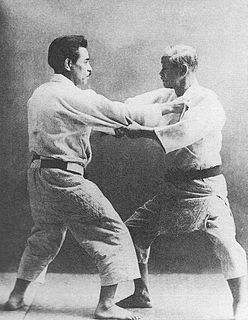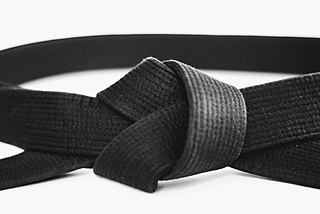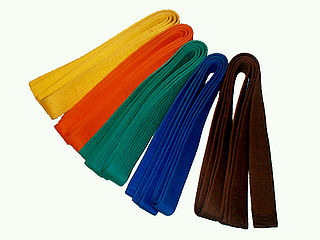
Judo,lit. "gentle way" is a system of unarmed combat,modern Japanese martial art and Olympic sport. Judo was created in 1882 by Jigoro Kano (嘉納治五郎) as an eclectic martial art,distinguishing itself from its predecessors due to an emphasis on "randori" instead of "kata" alongside its removal of striking and weapon training elements. Judo rose to prominence for its dominance over established jujutsu schools in tournaments hosted by the Tokyo Metropolitan Police Department,resulting in its adoption as the department's primary martial art. A judo practitioner is called a "judoka",and the judo uniform is called "judogi".

Taekwondo,Tae Kwon Do or Taekwon-Do is a Korean form of martial arts characterized by punching and kicking techniques,with emphasis on head-height kicks,spinning jump kicks,and fast kicking techniques. The literal translation for tae kwon do is "kicking," "punching," and "the art or way of." They are a kind of martial arts in which one attacks or defends with hands and feet anytime or anywhere,with occasional use of weapons. The physical training undertaken in Taekwondo is purposeful and fosters strength of mind through mental armament.
Hapkido is a hybrid Korean martial art. It is a form of self-defense that employs joint locks,grappling,throwing techniques,kicks,punches,and other striking attacks. It also teaches the use of traditional weapons,including knife,sword,rope,nunchaku,cane,short stick,and middle-length staff,gun,and bō(Japanese),which vary in emphasis depending on the particular tradition examined.

A dōjō is a hall or place for immersive learning or meditation. This is traditionally in the field of martial arts,but has been seen increasingly in other fields,such as meditation and software development. The term literally means "place of the Way" in Japanese.

The Aikikai is the original school of Aikido. It is centered on the Aikikai Foundation in Japan,and its figurehead is the Doshu. It is represented globally through the International Aikido Federation.

In East Asian martial arts,the black belt is associated with expertise,but may indicate only competence,depending on the martial art. The use of colored belts is a relatively recent invention dating from the 1880s.

Korean martial arts are fighting practices and methods which have their place in the history of Korea but have been adapted for use by both military and non-military personnel as a method of personal growth or recreation. The history of Korean martial arts can be traced as far back as the prehistoric era. The ancestors of modern Korean people migrated and settled in the Korean Peninsula as early as the 28th century BC,a geopolitical region besieged by thousands of known documented instances of foreign invasions. Consequently,the Korean people developed unique martial arts and military strategies in order to defend themselves and their territory.
Kumdo is a modern Korean martial art derived from Japanese Kendo. Though romanized in a number of ways when written,Kǒmdo or Geomdo, the meaning remains "the way of the sword" and is cognate with the Japanese term. As a martial art,Kumdo has become accepted in Korean culture and society since its introduction from Japan to the degree that the term "kumdo" has,in recent history,become a generic label for other Korean martial arts based upon Korean Swordsmanship. Therefore,kumdo can apply to the sporting and competitive form of swordsmanship,similar to Kendo,or it can be applied to other martial forms of Korean swordsmanship such as Haidong Gumdo or Hankumdo. Although related to Japanese Kendo,minor differences exist in Korean Kumdo due to appropriation and acculturation. Such differences include,but are not limited to,the use of native terminology,the use of blue flags rather than red flags for the referees and minor modifications to the uniform.
YoshinkanAikido is a style of aikido that developed after World War II in the Yoshinkan Dojo of Gozo Shioda (1915–1994). Yoshinkan Aikido is often called the "hard" style of aikido because the training methods are a product of Shioda's grueling life before the war. Shioda named his dojo "Yoshinkan" after a dojo of the same name that was built by his father,a physician,who wanted to improve both physical and spiritual health. The Yoshinkan style is currently the second largest aikido organization worldwide.
The Iwama Dōjō is a dōjō built by the founder of aikido,Morihei Ueshiba,who lived there from 1942 until his death in 1969. It is located in the former town of Iwama and became an important historical location for the development of aikido and "a Mecca to the aikido community." This dojo is also where Morihiro Saito,one of the founder's closest students,learned and taught aikido from 1946 until 2002 developing what is often referred to as the Iwama Style.

Kyū is a Japanese term used in modern martial arts as well as in tea ceremony,flower arranging,Go,shogi,academic tests and other similar activities to designate various grades,levels or degrees of proficiency or experience. In Mandarin Chinese,the same character 級is pronounced jí,and the term is used for academic tests. In Korea,the term geup is used. In Vietnamese martial arts,it is known as cấp (khớp).

The Kodokan Judo Institute (公益財団法人講道館),or Kōdōkan (講道館),is the headquarters of the worldwide judo community. The kōdōkan was founded in 1882 by KanōJigorō,the founder of judo,and is now an eight-story building in Tokyo.

The dan ranking system is used by many Japanese,Okinawan,Korean,and other martial art organizations to indicate the level of a person's ability within a given system. Used as a ranking system to quantify skill level in a specific domain,it was originally used at a Go school during the Edo period. It is now also used in most modern Japanese fine and martial arts.

Choi Yong-sool,alternative spelling Choi Yong-sul,was the founder of the martial art Hapkido. He was born in today's Chungcheongbuk-do,South Korea,and was taken to Japan during the Japanese occupation of Korea when he was eight years old. Choi later stated that he became a student of Takeda Sōkaku,and studied a form of jujutsu known as Daitō-ryūAiki-jūjutsu (大東流合気柔術) while in Japan. Choi returned to Korea after the end of World War II and in 1948 began teaching his art at a brewery owned by the father of his first student Seo Bok-Seob. He first called his art "Yu Sul (Korean: 유술)" or "Yawara " later changing it to "Yu Kwon Sool " and "Hap Ki Yu Kwon Sool " and eventually Hapkido.
Dōjōkun is a Japanese martial arts term literally meaning rules. They are generally posted at the entrance to a dōjō or at the "front" of the dojo (shomen) and outline behaviour expected and disallowed. In some styles of martial arts they are recited at the end of a class.
Shorin-ryu Shidokan is the main branch of Shorin-ryūstyle of Okinawan karate,started by Katsuya Miyahira,Hanshi 10th Dan.
ShindōMunen-ryū or ShintōMunen-ryū (神道無念流) is a Japanese koryū martial art school founded by Fukui Hyōemon Yoshihira (福井兵右衛門嘉平) in the early 18th century. The style rapidly gained popularity throughout Japan due to the efforts of Togasaki Kumataro,Okada Junmatsu,Saito Yakuro,and his sons Shintaro and Kannosuke.
Tamiya-ryūIaijutsu (民弥流居合術) is a martial art founded by Kamiizumi MagojirōYoshitane (上泉孫次郎義胤),who later took his mother's name and became known as Tamiya Gon'emon Muneshige (民弥権右衛門宗重). The art is now part of the Kuroda family bujutsu.
Bugō are nicknames used in the Japanese martial arts. The word is composed of the symbols 武 and 号. In English,the term is sometimes translated as "martial name" or "warrior name" with similar equivalents in other languages.
Kanbukan was one of the earliest Karate organizations made in Post-War Japan and is considered the birthplace of the Bōgutsuki Karate.












